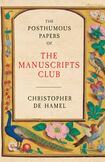
Among the many fascinating discoveries to be made in this marvellous book, the one that will interest Irish readers in particular, is the fact that what is “effectively that last book of the Middle Ages” is held in the Chester Beatty Library in Dublin Castle. It is the Beatty Rosarium of 1545, written by Antonius van Damme and illustrated by Simon Bening.
Unfortunately, or at least inconveniently, the Rosarium is not on display in the museum at present, as your reviewer can attest. The delightfully helpful staff there offered the information that only about 1 per cent- yes, 1 per cent – of the Beatty treasures can be exhibited at any one time. This is sad, but also cheering: what a bounty Sir Alfred (1875-1968), the Anglo-American mining millionaire, left to his adopted country, even if we can only see fragments of it, in rotation.
Simon Bening (c 1484-1561) is one of Christopher de Hamel’s favourite illustrators – or illuminators: choose your preferred term – and a whole chapter of this book is devoted to him. It is hard to say, and the author doesn’t help us to decide, whether Bening should be considered an artist or a craftsman. Anyway, in those days, and in that line of work, the distinction between the two was not as marked as it is now.
Bening was based in Bruges, and probably knew the likes of Jan van Eyck and Hans Memling, two among the many master painters working in the city at the time. The Bening family business was illustrated books – Bening most likely served his apprenticeship in his father’s workshop in Ghent and were, as de Hamel writes, “as much at home among the Flemish artists as they were in the book trade”.
‘Irish teenagers are so innocent. Where I’m from we learn not to be naive’
Oesophageal cancer: ‘I was fine, there was nothing wrong with me’
Doireann Garrihy restores some celeb lustre to troubled 2FM with larky verve
Mortgage-free in a cosy cottage before age 40: ‘I don’t have any savings, but I don’t have any debt either’
We must forgive Christopher de Hamel his silly titles. His previous book was called, after Gurdjieff, Meetings with Remarkable Manuscripts, while this one, as Dickens fans will immediately recognise, is named in memory of Mr Pickwick. There is nothing silly about the books themselves. De Hamel’s light tone and playful procedures cannot hide the fact that he is a superb scholar, with a depthless knowledge of his subject. He worked at Sotheby’s and then was at Cambridge University, and, as a biographical note informs us, “has probably seen and catalogued more medieval manuscripts than anyone alive, and his delight and enthusiasm run through all he writes”.
He begins his introduction by recalling a dinner given by the Medieval Manuscripts Society in Cambridge, Massachusetts, in 2016. The society, he tells us, is wonderfully unstuffy, and eclectic in its membership. “A delight in manuscripts is the only qualification for belonging, and there is no hierarchy or subscription. We looked around the room with a real sense of being among like-minded friends.”
And that is exactly how we, his readers, feel when he draws us cheerfully into his history of what might seem initially not the most exciting of subjects.
The book is divided into 12 chapters, each one devoted to an individual. It starts with “The Monk”, St Anselm, Archbishop of Canterbury after the Norman invasion in 1066, then moves on through an account of the collector the Duc du Berry (1340-1416), commissioner of what is surely the most beautiful of medieval illuminated books, the Très Riches Heures, illuminated by the incomparable Limburg brothers.
There is “The Bookseller”, the canny Vespasiano de Bisticci of Florence – his house is to be seen in a 1470 map which de Hamel reproduces – “The Antiquary”, Sir Robert Cotton, whose treasures included, we are told, “the only extant manuscript of any Anglo-Saxon epic, the incomparable Beowulf itself”. Then there is “The Savant”, the endlessly irascible know-all Abbé Jean-Joseph Rive, whose La chasse aux biblioghraphes (1789) is, according to de Hamel, “the most bad-tempered book on manuscripts ever written”.
Perhaps the most fascinating chapter is the last, “The Curator”. This tells the story of Belle da Costa Green, curator and buyer for one of the richest men of his time, J Pierpont Morgan, who built and stocked that great New York institution, the Morgan Library. Belle Green, as she was then called, came to work for Morgan in 1905 at a starting salary of $75 a month.
Within a few years she was spending what today would be multiples of millions on the purchase of manuscripts for the library. So authoritative was she, and so inflexible in her judgment, that in 1926 Pierpont Morgan’s son, Jack, on a trip to England, bought four books – “glitzy” items, de Hamel writes – for £100,000 because, as he confessed, “he was too frightened of Belle Green to come home without them”.
Belle became a leading figure in her field; she was also the long-time lover of the art historian Bernard Berenson. What almost no one knew, though, was that Belle da Costa Green was not of Portuguese origin, as she claimed, but was an African-American with skin pale enough for her to pass for white.
And more than pass. De Hamel writes that in time “the bright-eyed young organiser of Pierpont Morgan’s early acquisitions had gradually evolved into a grande dame of America”. She gloried in what she had made of herself, yet never lost her sense of the absurdity of it all. “Of course I’m a Hussey (or is it Hussy?),” she wrote in 1927 to Berenson, himself a grand homme who also wasn’t all he seemed, “but thanks be-to-Gawd, I’ve lived and am still Alive albeit decrepit”. She did not die until 1950. Black Lives Matter.












